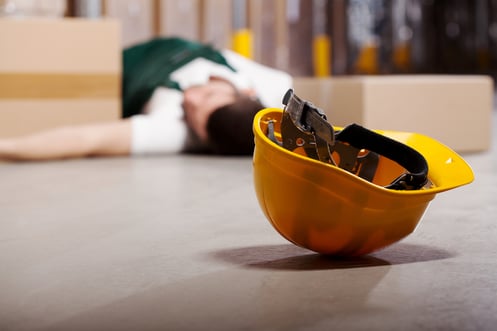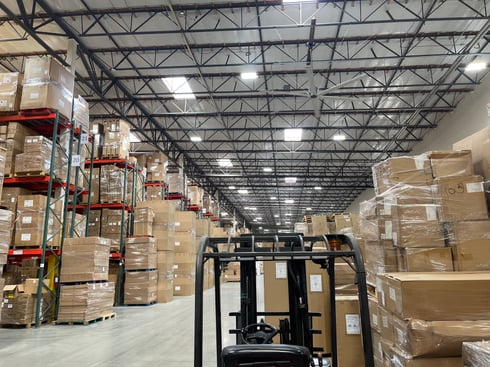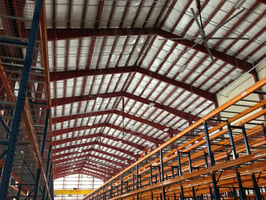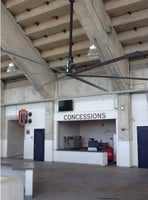Warehouse Accidents

Warehouse accidents are a serious issue that can have serious consequences for warehouse workers and the overall operation of the warehouse. According to the Bureau of Labor Statistics, in 2019, warehouses have one of the highest rates of nonfatal occupational injuries among private industries in the United States. In this blog, we will look at some of the most common warehouse accidents, the costs associated with these accidents, and ways warehouse workers and managers can prevent them from occurring in the future.
It Matters to MacroAir
We know that working in a warehouse can be tough, but at MacroAir, we're committed to helping improve the safety and comfort of your warehouse. As the inventor of the High Volume Low Speed (HVLS) industrial ceiling fan, we know a thing or two about warehouse safety. Our technology is based on the principle that moving air slowly is more efficient, and our fans move air in all directions to keep things fresh and comfortable. The increased airflow helps reduce temperatures and humidity levels, and keeps equipment and floors dry, creating a safer warehouse for employees.
Common Warehouse Accidents

Warehouses can be dangerous, with a variety of hazards that can lead to accidents and injuries. One common hazard in warehouses is extreme heat, which can not only be uncomfortable for workers but can also contribute to accidents. When workers are too hot, they may be more prone to mistakes or lapses in judgment. Some of the most common warehouse accidents include forklift accidents, accidental falls, and major falls or strikes causing traumatic brain injuries.
Forklift Accidents
Forklifts are a common piece of equipment in warehouses and are essential for moving and storing heavy objects. However, they can also be a source of serious accidents if not used properly. In 2019, forklifts were involved in over 35,000 serious injuries and an average of 87 accidental deaths in the United States, according to the Occupational Safety and Health Administration (OSHA). To prevent forklift accidents, it is important to ensure that all forklift operators are properly trained and certified and that they follow all safety procedures when operating a forklift. This includes wearing protective equipment, such as hard hats and safety glasses, and following proper load-handling techniques.
Accidental Falls
Accidental falls are another very common type of warehouse accident. These can occur when workers are working on ladders or pallet racks, or when they slip or trip and fall on the warehouse floor. To prevent slips and falls, it is important to ensure that all workers have access to the proper safety equipment, such as fall protection gear and non-slip shoes. It is also important to keep the warehouse floor clear of any hazards, such as spills or debris, to properly maintain ladders and other equipment, and to keep concrete floors dry in your warehouse.
Traumatic Brain Injuries
Warehouse workers are at risk of suffering traumatic brain injuries (TBIs) in a variety of ways, such as falling or being struck by a moving object. TBIs can lead to long-term disabilities or even death. To prevent TBIs, it is important to follow all safety procedures and to wear protective equipment when handling heavy objects. It is also important to properly maintain equipment and to have a hazard communication program.
A hazard communication program is a safety program that aims to inform employees about hazardous materials that they may be exposed to while working. It is designed to protect workers from potential chemical hazards by providing them with information about the dangers, properties, and potential effects of the hazardous materials that they may encounter on the job. The program typically includes supplies for labeling hazardous materials, training employees on handling and emergency procedures, and maintaining a list of hazardous materials in the workplace.
Warehouse Accident Costs

The costs associated with warehouse accidents can be significant, both in terms of employee injuries and lost productivity. According to the National Safety Council, the indirect costs of a workplace injury, such as lost productivity and training, can be as much as four times that of the direct costs, which include medical expenses and workers' compensation. In addition, workplace injuries can lead to decreased morale and increased turnover among warehouse workers. Even though it is impossible to know the total number of warehouse accidents occurring every year, we do know that according to OSHA that forklift accidents alone total nearly 100,000. Now consider our previously mentioned statistic also from OSHA stating that the average cost of each workplace injury is $39,000.
To help prevent these costs, it is important for warehouse managers to prioritize safety and to have a robust safety program in place. Some common safety measures in warehouses might include
- Safety training programs for all employees
- Clear and well-marked pathways and aisles to prevent slips and trips
- Signs and labels to identify potential hazards and warn of dangers
- Protective equipment for employees, such as hard hats, gloves, and safety glasses
- Safety guards and barriers to protect workers from moving machinery and equipment
- Regular inspections and maintenance of equipment to ensure that it is in good working order
- Emergency response plans and drills to prepare for potential accidents or incidents
- Adequate lighting to ensure that workers can see their surroundings clearly
- First aid supplies and trained first responders to provide immediate medical assistance in case of an accident
- Safety committees or other groups to regularly review and assess safety practices and procedures in the warehouse.
It is important for all employers to prioritize the safety of their workers and to implement effective safety measures to prevent accidents and injuries. It is also important for employers to report all workplace accidents and injuries to the appropriate authorities as required by law.
How to Prevent Workplace Accidents

To prevent warehouse accidents, it is important for warehouse managers to prioritize safety and create a culture of safety within the workplace. This can be achieved through training, hazard communication, and the use of protective equipment.
Training
Proper training is essential to preventing warehouse accidents. This includes training for forklift operators, as well as training for all warehouse workers on safety procedures and the proper use of equipment.
Culture
A positive safety culture is one in which safety is a priority for everyone in the workplace. This includes both managers and workers, who should be encouraged to speak up about any safety concerns they may have.
Preventative measures
In addition to training and creating a culture of safety, there are several preventative measures that can be taken to reduce the risk of warehouse accidents. These include conducting regular safety inspections, properly maintaining pieces of equipment, and properly storing hazardous materials.
One effective preventative measure to help reduce the risk of warehouse accidents is simply adding a MacroAir High Volume Low Speed (HVLS) fan. An HVLS fan is a type of industrial fan that is designed to circulate air in a warehouse or other large space. The fans work by using large-diameter, slow-moving blades to generate a column of air that is distributed throughout the space. The movement of the air can help to keep the space at an optimal temperature, improve poor ventilation, and improve air quality, all of which can help reduce the risk of accidents and injuries. In addition to providing a cooling effect, the circulation of air can also help to reduce the build-up of moisture, dust, and other particles, which can contribute to slips, trips, and falls. By improving the comfort and air quality in a warehouse, an HVLS fan can help to create a safer and more pleasant work environment for employees.
Final Thoughts

Warehouse accidents can have serious consequences for both workers and businesses. By prioritizing safety, training employees, and taking preventative measures, warehouse managers can help to reduce the risk of accidents and create a safer workplace for all. Remember, the key to preventing warehouse accidents is to be aware of your surroundings and to follow all safety procedures.
MacroAir fans are here to help keep your warehouse safe. To find out more about the benefits of HVLS fans, click the link below.




